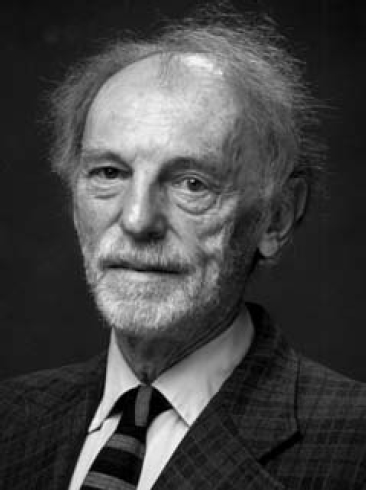
1913–2005
Elected in 1980
“For contributions in applied mathematics and its use in solving important engineering problems in ship design.”
BY RONALD W. YEUNG, SARAH WIKANDER, AND J. RANDOLPH PAULLING
JOHN VROMAN WEHAUSEN, professor of engineering science, emeritus, at the University of California, Berkeley, and a world leader in the field of marine hydrodynamics, died peacefully at the Kaiser Oakland Medical Center on October 6, 2005, at the age of 92.
John Wehausen was born on September 23, 1913, in Duluth, Minnesota, and grew up in Oak Park, Illinois. At the University of Michigan he received his undergraduate degree in mathematics in 1934, followed by a master’s in physics in 1935, and a doctorate in mathematics in 1938.
In 1937, Wehausen began his first teaching position as an instructor in mathematics at Brown University. It was there that he met his future wife, Mary Katherine Wertime, a Ph.D. candidate in mathematics. They had been married 62 years when she passed away in January 2001.
After holding teaching positions at Columbia University and the University of Missouri, Wehausen contributed to the government’s efforts at the end of World War II by working for the U.S. Navy in operations research. He joined the David Taylor Model Basin in Bethesda, Maryland, as a mathematician and, during his three-year tenure there, met George Weinblum, the renowned German ship hydrodynamicist. His interest in water-wave theory and ship hydrodynamics can be traced to that time and mentor.
Used with the permission of the Academic Senate of the University of California.
Wehausen’s training in mathematics and his exceptional language abilities were recognized when he was selected as executive editor of Mathematical Reviews in 1950, a post he held until 1956, when he was recruited by UC Berkeley. There he helped establish the Department of Naval Architecture, developing a graduate-degree program that stressed hydrodynamics and structural mechanics in the marine field. That rigorous academic curriculum eventually became a model for similar programs worldwide. In 1996 the department became a Graduate Group in Ocean Engineering within the Graduate Division. Starting in the fall of 2005, the group became a major field of study within UC Berkeley’s Department of Mechanical Engineering.
Besides being a popular and dedicated teacher, Wehausen contributed to original scientific research in the areas of ship waves, ship maneuverability, floating systems in waves, and ship-generated solitary waves. He was an advocate of systematic theoretical analysis based on rational mechanics principles. In an era when engineers are building container ships with capacities of 10,000 containers, floating offshore oil production systems for operation in water depths exceeding 2,000 meters, and marine vehicles that travel at extreme speeds in high sea states, his visionary approach based on first principles has become all the more important.
His review articles are especially highly regarded. In 1960 he published the 350-page article “Surface Waves” (with the late UC Berkeley Professor Edmund Laitone) in Handbuch der Physik. This synthesis of the field has had such a wide and long-lasting impact that it was republished in 2002 in an online version to provide free access for a worldwide audience (http://www.coe.berkeley.eduSurfaceWaves). Two other authoritative reviews—“The Wave Resistance of Ships” in Advances in Applied Mechanics (1974) and “The Motion of Floating Bodies” in Annual Review of Fluid Mechanics (1972)—are considered classics in his field.
Wehausen retired from UC Berkeley in 1984, but for many years remained active in research and university affairs. Among his other activities, he chaired the Committee on Memorial
Resolutions of the Academic Senate from 1991 to 1997. He was a member of the National Academy of Engineering and a life fellow of the Society of Naval Architects and Marine Engineers, which awarded him the Kenneth Davidson Medal for outstanding scientific accomplishment in research. Among the many other honors he earned throughout his career was an honorary doctorate degree from the Joseph Fourier University in Grenoble, France, where he had taught during a sabbatical leave.
In June 2002 international colleagues and former students paid tribute to Wehausen by organizing a special symposium during the Offshore Mechanics and Arctic Engineering Conference in Oslo, Norway. At that event he was awarded the Lifetime Achievement Award of the American Society of Mechanical Engineers International.
Wehausen had a great interest in languages. He was fluent in German and French, read Russian well, and had a working knowledge of other Western European and Slavic languages. To try his hand at a non-Indo-European language, he studied Turkish and lectured in that language during a sabbatical leave at the Technical University of Istanbul. For many years he read daily papers in three languages. He wrote articles in French and German and gave lectures in these languages. He also had a great love for classical music, which was strengthened by Kay Wehausen’s musical background and training. That love was passed on to their four children. After moving to Berkeley, he taught himself the recorder and bought the family a harpsichord so they could play chamber music together.
Wehausen is survived by his four children—Sarah Wikander and her husband Carl, Peter Wehausen and his wife Suzanne, Julia Wenk and her husband Rudy, and John Wehausen and his wife Carolyn—and by six grandchildren and one great-grandson.
In June 2006, thanks to the generosity of family, friends, and former students, a John V. Wehausen Memorial Endowment was established at the UC Berkeley Foundation to provide a scholarship for graduate study in Wehausen’s areas of professional interest.




